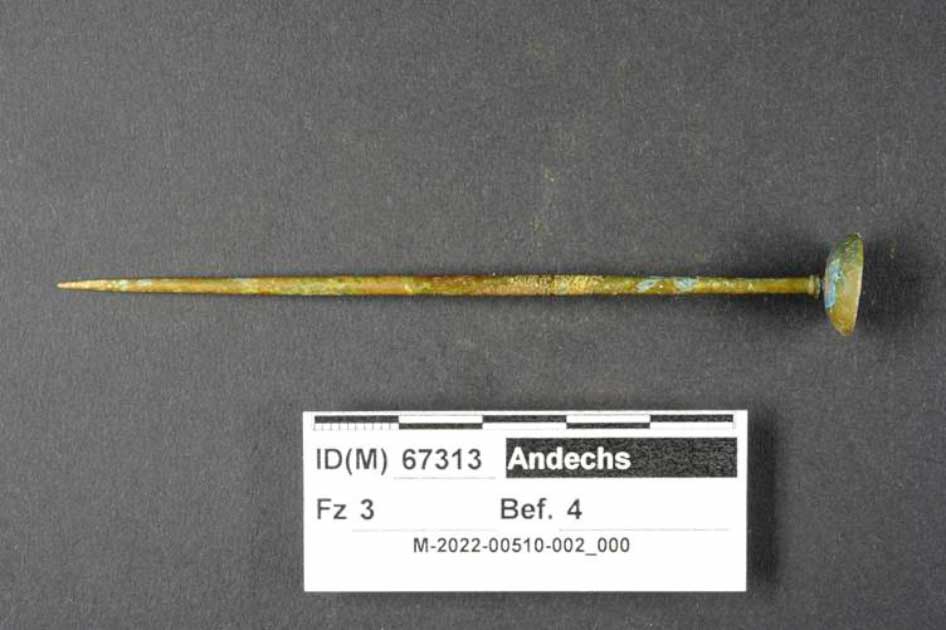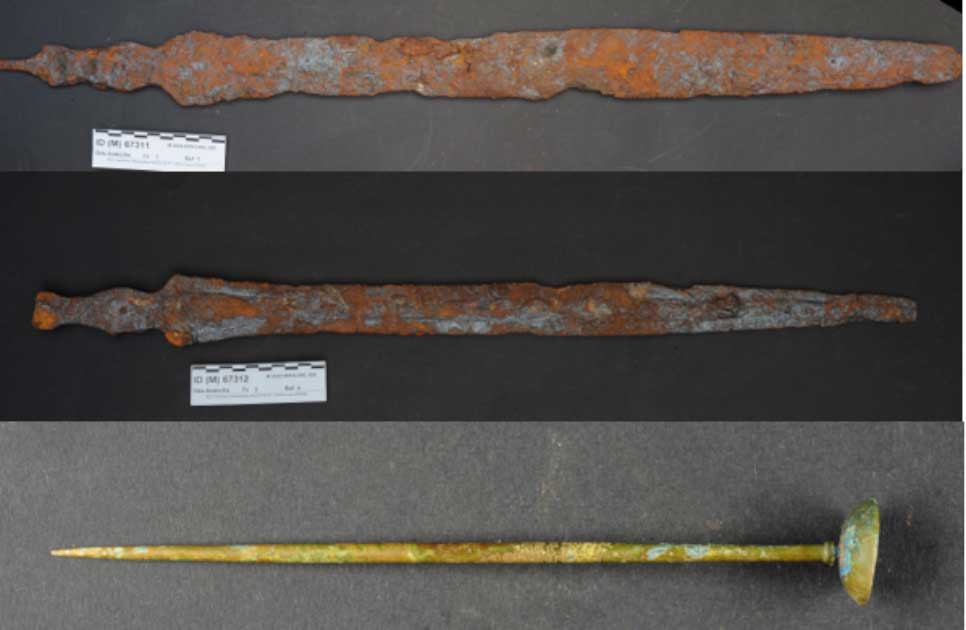2,800-year-old Hallstatt Swords Rewrite Bronze to Iron Age Technological Leap
Two extremely rare early Iron Age Hallstatt swords dating to the eighth century BC have been unearthed in the Bavarian town of Andechs in Starnberg district. These 2800-year-old swords are among the oldest iron swords to be discovered in southern Germany, reports Arkeonews. What makes the find so singular is that the swords belong to Hallstatt period that straddles the Bronze and Iron Ages, and the transition is clearly visible in the designs of the recently discovered ancient Hallstatt swords.
The latest two Hallstatt swords were found in March by workers at the site of a new fire station in the town of Andechs, Bavaria, Germany. They were deposited in two separate shallow graves barely 40 centimeters (16 inches) beneath the ground and were clearly grave offerings. Three fragmented ceramic vessels were also unearthed alongside the Hallstatt swords. Six other graves were found with funerary offerings of bronze jewelry, spindle whorls, and a bowl-head pin, according to the History Blog.
The cremated human remains were concentrated in certain areas, indicating that they were originally placed in organic receptacles like cloth bags or wooden containers that have since decomposed.
The Hallstatt swords are 76 and 66 centimeters (30 inches and 26 inches) long and both are 6 centimeters (2.4 inches) wide. While the shorter sword was suitable as a stabbing weapon for man-to-man combat, the longer and heavier one was a slashing and cutting weapon that could be wielded from a raised position, for example seated on horseback.

The shorter of the two Hallstatt swords, which are about 2,800 years old, found in southern Germany. These ancient swords are shedding new light on the historical transition from the Bronze Age to the Iron Age in central Europe. (© Bayerisches Landesamt für Denkmalpflege)
The New Hallstatt Swords: Made at Bronze to Iron Age Cusp
Experts have dated the swords to the Hallstatt period, so named after the site of Hallstatt in Austria where a salt mine and 1,300 burials belonging to this culture have been found. The Hallstatt culture was predominant in western and central Europe in the Late Bronze Age from the 12th to the 8th century BC, and the Early Iron Age from the 8th to the 6th century BC.
- The Powerful Hallstatt Culture: Foundation of the Proto-Celtic World
- Peeking Behind the Veil: Unique and Decorative Burial Urns with Faces in the Pomeranian Culture
Remarkably, the swords have been dated by experts to the very point in time when the Hallstatt culture was transitioning from the Bronze Age to the Iron Age. This is visible in the design of the swords. The older sword was made in the shape and style of a bronze sword. The design of the slightly younger Hallstatt sword, also made in the eighth century BC, on the other hand, was designed to take full advantage of the stronger properties of iron.
“These two swords are evidence of a technological evolution. They tell us about the beginnings of ironworking and provide us with information about changes in weapons technology,” said Prof. Mathias Pfeil, who is head of the Bavarian State Heritage Office stated, according to LovecPokladu.cz.

This bowl-head pin made of a non-ferrous metal alloy with a length of 9.6 centimeters or 3.8 inches was found near the two Hallstatt swords recently unearthed in Bavaria, Germany. (© Bayerisches Landesamt für Denkmalpflege)
Material Traces on Both Hallstatt Sword Blades Tell Us More
Micro-fine blasting technology was used by a team of restorers in the Bavarian State Office for the Preservation of Monuments in Munich to clean the partially corroded blades, and they were then minutely examined. The researchers have been able to recover interesting material traces from the Hallstatt blades that have allowed them to infer what the swords initially looked like and how they were placed in the graves.
The handles of the swords have long disappeared but one of the blades showed traces of animal horn on the handle “tongue,” indicating that the handle was made of horn. Two of the four rivets that fastened the horn plates onto the blade are still extant.
The other blade, however, has no such rivets, leading experts to conclude that the handle was perhaps fastened to the blade with a resin glue. There is no way of determining what this second handle was made of since the material has left no traces.
That is not all, however. Multi-layer woven linen fabric traces were found on the both the blades as well as the traces of cords. This suggests that they were wrapped in fabric and tied with cord before being buried with the grave occupants.
- The Iron Age Diet: Lots Of Blue Cheese and Beer, Poop Study Shows
- Celtic Prince or Princess? Researchers Have Finally Ascertained Who Owned an Opulent 2500-Year-Old Tomb in France
Only two of the eight Bavarian Andechs graves had offerings that were weapons. The two graves with the swords probably belonged to warriors or elites. Dr Jochen Haberstroh of the Bavarian State Heritage Office, who supervised the excavation, said, “There is no doubt that graves with swords distinguish the regional elite, whose status symbols included the most modern weapons of the time.”
Top image: Top; The short Hallstatt sword with design was characteristic of the Bronze Age. Middle; Longer sword, designed to take advantage of the stronger properties of iron and was dated to the very beginnings of the Iron Age. Bottom; Bowl-head pin made of a non-ferrous metal alloy. Source: © Bayerisches Landesamt für Denkmalpflege
By Sahir Pandey
References
Altuntas, L. 2022 . 2800-year-old two Swords found in Germany from the start of the Iron Age. Available at: https://arkeonews.net/2800-year-old-two-swords-found-in-germany-from-the-start-of-the-iron-age/.
Lovecpokladu.cz. 2022. Unique 2,800-year-old swords discovered in Germany prove the technological leap of the Hallstatt Age. Available at: https://www.lovecpokladu.cz/en/home/unique-2-800-year-old-swords-discovered-in-germany-prove-the-technological-leap-of-the-hallstatt-age-9136.
The History Blog. 2022. Early Iron Age swords found in Bavaria. Available at: http://www.thehistoryblog.com/archives/64237.

















